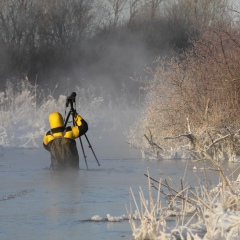"Видишь дамана? И я не вижу.. А он есть!"
Это откуда-то из приключенческой фантастики. Когда шел штурмовать неведомую крепость (увидев соответствующий значок на карте), а зашел в прекрасное и прекрасно-безлюдное ущелье, не отмеченное ни в одном путеводителе.
Присел отдохнуть и попить чай...и начал замечать, что ущелье-то - живое. Что это многоэтажный дом, и его обитатели все это время безмолвно наблюдали за тобой с верхних этажей.
Один зверек полез на скалу и этим выдал себя. Забрался на "наблюдательную галерею", а там уже на постах группа сородичей. Бдят.
Сколько их там было в других расщелинах и галерях, и не представить.
Будучи не сильна в зоологии, я предположила, что это то ли суслики, то ли сурки.
Но не я одна все перепутала.
"Существует мнение, что упоминающиеся в Библии «зайцы», обозначенные словом «шафан» (shaphan — שָּׁפָן), на самом деле были даманами. Издалека они действительно напоминают крупных кроликов. Из иврита это слово перешло в язык финикийцев, которые, видимо, ошибочно приняли кроликов Иберийского полуострова за даманов, дав стране название I-Shaphan-im — «остров даманов». Позднее от этого названия произошло латинское Hispania и современное «Испания»[2]." (Википедия)
Библейские зайцы - товарищи непростые.
Лихо лазать по скалам (до 4500 м над уровнем моря) им помогает особое строение лап, с присосками, почти как у мух.
А вот с терморегуляцией им не повезло, так что приходится подолгу греться на солнышке, а по ночам - греть друг друга.
И вообще это не какой-то там грызун, а родственник слона!
И да, вопрос на наблюдательность. Сколько даманов на первой и последней фотографиях?
Это откуда-то из приключенческой фантастики. Когда шел штурмовать неведомую крепость (увидев соответствующий значок на карте), а зашел в прекрасное и прекрасно-безлюдное ущелье, не отмеченное ни в одном путеводителе.
Присел отдохнуть и попить чай...и начал замечать, что ущелье-то - живое. Что это многоэтажный дом, и его обитатели все это время безмолвно наблюдали за тобой с верхних этажей.
Один зверек полез на скалу и этим выдал себя. Забрался на "наблюдательную галерею", а там уже на постах группа сородичей. Бдят.
Сколько их там было в других расщелинах и галерях, и не представить.
Будучи не сильна в зоологии, я предположила, что это то ли суслики, то ли сурки.
Но не я одна все перепутала.
"Существует мнение, что упоминающиеся в Библии «зайцы», обозначенные словом «шафан» (shaphan — שָּׁפָן), на самом деле были даманами. Издалека они действительно напоминают крупных кроликов. Из иврита это слово перешло в язык финикийцев, которые, видимо, ошибочно приняли кроликов Иберийского полуострова за даманов, дав стране название I-Shaphan-im — «остров даманов». Позднее от этого названия произошло латинское Hispania и современное «Испания»[2]." (Википедия)
Библейские зайцы - товарищи непростые.
Лихо лазать по скалам (до 4500 м над уровнем моря) им помогает особое строение лап, с присосками, почти как у мух.
А вот с терморегуляцией им не повезло, так что приходится подолгу греться на солнышке, а по ночам - греть друг друга.
И вообще это не какой-то там грызун, а родственник слона!
И да, вопрос на наблюдательность. Сколько даманов на первой и последней фотографиях?
"See the daman? And I don't see .. But he is!"
It's from somewhere in adventure fiction. When I went to storm an unknown fortress (after seeing the corresponding icon on the map), I went into a beautiful and beautifully deserted gorge, not marked in any guidebook.
He sat down to rest and drink tea ... and began to notice that the gorge was alive. That this is a multi-storey building, and its inhabitants have been silently watching you from the upper floors all this time.
One animal climbed the rock and thereby betrayed himself. He climbed into the "observation gallery", and there already at the posts a group of relatives. Vigil.
How many of them were in other crevices and galleries, and not imagine.
Being not strong in zoology, I suggested that it was either ground squirrels or groundhogs.
But I wasn’t alone all mixed up.
"There is an opinion that the" hares "mentioned in the Bible, indicated by the word" shafan "(shaphan - שָּׁפָן), were actually damans. From afar they really resemble large rabbits. From Hebrew this word passed into the language of the Phoenicians, which, apparently, were mistaken they took the rabbits of the Iberian Peninsula for damans, giving the country the name I-Shaphan-im - “Daman island.” Later, Latin Hispania and modern “Spain” came from this name. " (Wikipedia)
Biblical hares are not easy comrades.
The special structure of paws, with suction cups, almost like flies, helps them to climb rocks (up to 4500 m above sea level).
But they were not lucky with thermoregulation, so they have to bask in the sun for a long time, and warm each other at night.
In general, this is not some rodent there, but a relative of an elephant!
And yes, a question for observation. How many dams in the first and last photographs?
It's from somewhere in adventure fiction. When I went to storm an unknown fortress (after seeing the corresponding icon on the map), I went into a beautiful and beautifully deserted gorge, not marked in any guidebook.
He sat down to rest and drink tea ... and began to notice that the gorge was alive. That this is a multi-storey building, and its inhabitants have been silently watching you from the upper floors all this time.
One animal climbed the rock and thereby betrayed himself. He climbed into the "observation gallery", and there already at the posts a group of relatives. Vigil.
How many of them were in other crevices and galleries, and not imagine.
Being not strong in zoology, I suggested that it was either ground squirrels or groundhogs.
But I wasn’t alone all mixed up.
"There is an opinion that the" hares "mentioned in the Bible, indicated by the word" shafan "(shaphan - שָּׁפָן), were actually damans. From afar they really resemble large rabbits. From Hebrew this word passed into the language of the Phoenicians, which, apparently, were mistaken they took the rabbits of the Iberian Peninsula for damans, giving the country the name I-Shaphan-im - “Daman island.” Later, Latin Hispania and modern “Spain” came from this name. " (Wikipedia)
Biblical hares are not easy comrades.
The special structure of paws, with suction cups, almost like flies, helps them to climb rocks (up to 4500 m above sea level).
But they were not lucky with thermoregulation, so they have to bask in the sun for a long time, and warm each other at night.
In general, this is not some rodent there, but a relative of an elephant!
And yes, a question for observation. How many dams in the first and last photographs?




У записи 8 лайков,
0 репостов,
235 просмотров.
0 репостов,
235 просмотров.
Эту запись оставил(а) на своей стене Ксения Шигапова





























